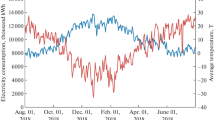Abstract
Electric load forecasting becomes one of the most critical factors for the economic operation of power systems due to the rapid increment of daily energy demand in the world. The energy usage of the electricity demand is higher than the other energy sources in Sri Lanka according to the record of Generation Expansion Plan—2016, Ceylon Electricity Board, Sri Lanka. Moreover, forecasting is a hard challenge due to its complex nature of consumption. In this research, the long-term electric load forecasting based on optimized artificial neural networks (OANNs) is implemented using particle swarm optimization (PSO) and results are compared with a regression model. Results are validated using the data collected from Central Bank annual reports for thirteen years from the year 2004–2016. The choice of the inputs for ANN, OANNs, and regression models are given depends on the values obtained through the correlation matrix. The training data sets used in the proposed work are scaled between 0 and 1, and it is obtained by dividing the entire data set by its large value. The experimental results show that OANN has better accuracy in forecasting compared to ANN and regression model. The forecasting accuracy of each model is performed by the mean absolute percentage error (MAPE).
Access this chapter
Tax calculation will be finalised at checkout
Purchases are for personal use only
Similar content being viewed by others
References
Beaty HW (2001) Handbook of electric power calculations. McGraw-Hill
Singh AK, Ibraheem SK, Muazzam M, Chaturvedi DK (2013) An overview of electricity demand forecasting techniques. In: National conference on emerging trends in electrical, instrumentation & communication engineering 2013, Network and complex systems, pp 38–48.
Chakhchoukh Y, Panciatici P, Mili L (2011) Electric load forecasting based on statistical robust methods. IEEE Trans Power Syst 26(3):982–991
Chow JH, Wu FF, Momoh JA (2005) Applied mathematics for restructured electric power systems. In: Applied mathematics for restructured electric power systems, Springer, pp 1–9
Starke M, Alkadi N, Ma O (2013) Assessment of industrial load for demand response across US regions of the western interconnect. Oak Ridge National Lab. (ORNL), Oak Ridge, TN, US
Ghanbari A et al (2009) Artificial neural networks and regression approaches comparison for forecasting Iran’s annual electricity load. In: International conference on power engineering, energy and electrical drives, 2009, POWERENG’09. IEEE
Abd-El-Monem H (2008) Artifical intelligence applications for load forecasting
Zhang F, Cao J, Xu Z (2013) An improved particle swarm optimization particle filtering algorithm. In: 2013 International conference on communications, circuits and systems (ICCCAS). IEEE
Jiang Y et al (2007) An improved particle swarm optimization algorithm. Appl Math Comput 193(1):231–239
Samuel GG, Rajan CCA (2015) Hybrid: particle swarm optimization genetic algorithm and particle swarm optimization shuffled frog leaping algorithm for long-term generator maintenance scheduling. Int J Electr Power Energy Syst 65:432–442
Chunxia F, Youhong W (2008) An adaptive simple particle swarm optimization algorithm. In: Control and decision conference, 2008. CCDC 2008. Chinese. IEEE
Subbaraj P, Rajasekaran V (2008) Evolutionary techniques based combined artificial neural networks for peak load forecasting. World Acad Sci Eng Technol 45:680–686
Daş GLS (2017) Forecasting the energy demand of Turkey with a NN based on an improved particle swarm optimization. Neural Comput Appl 28(1): 539–549
Jeenanunta C, Abeyrathn KD (2017) Combine particle swarm optimization with artificial neural networks for short-term load forecasting. ISJET 8:25
Hafez AA, Elsherbiny MK (2016) Particle swarm optimization for long-term demand forecasting. In: Power systems conference (MEPCON), 2016 eighteenth international middle east. IEEE
Rumelhart DE, Hinton GE, Williams RJ (1986) Learning representations by back-propagating errors. Nature 323(6088):533
Mazzoni P, Andersen RA, Jordan MI (1991) A more biologically plausible learning rule for neural networks. Proc Natl Acad Sci 88(10):4433–4437
Dilhani MS, Jeenanunta C (2017) Effect of neural network structure for daily electricity load forecasting. In: Engineering research conference (MERCon), 2017 Moratuwa. IEEE
Samarasinghe S (2016) Neural networks for applied sciences and engineering: from fundamentals to complex pattern recognition. Auerbach Publications
Kennedy J, Eberhart RC (1997) A discrete binary version of the particle swarm algorithm. In: 1997 IEEE international conference on systems, man, and cybernetics. Computational cybernetics and simulation. IEEE
Eberhart R, Kennedy J (1995) A new optimizer using particle swarm theory. In: Proceedings of the sixth international symposium on micro machine and human science, 1995. MHS’95. IEEE
AlRashidi M, El-Naggar K (2010) Long term electric load forecasting based on particle swarm optimization. Appl Energy 87(1):320–326
Meissner M, Schmuker M, Schneider G (2006) Optimized particle swarm optimization (OPSO) and its application to artificial neural network training. BMC Bioinf 7(1):125
Freitag S, Muhanna RL, Graf W (2012) A particle swarm optimization approach for training artificial neural networks with uncertain data. In: Proceedings of the 5th international conference on reliable engineering computing, Litera, Brno
Tripathy AK et al (2011) Weather forecasting using ANN and PSO. Int J. Sci Eng Res 2:1–5
Shayeghi H, Shayanfar H, Azimi G (2009) STLF based on optimized neural network using PSO. Int J Electr Comput Eng 4(10):1190–1199
Sarhani M, El Afia A (2015) Electric load forecasting using hybrid machine learning approach incorporating feature selection. In: BDCA
Author information
Authors and Affiliations
Corresponding author
Editor information
Editors and Affiliations
Rights and permissions
Copyright information
© 2021 The Author(s), under exclusive license to Springer Nature Singapore Pte Ltd.
About this paper
Cite this paper
Shyamali Dilhani, M.H.M.R., Wagarachchi, N.M., Kumara, K.J.C. (2021). Electricity Load Forecasting Using Optimized Artificial Neural Network. In: Smys, S., Balas, V.E., Kamel, K.A., Lafata, P. (eds) Inventive Computation and Information Technologies. Lecture Notes in Networks and Systems, vol 173. Springer, Singapore. https://doi.org/10.1007/978-981-33-4305-4_48
Download citation
DOI: https://doi.org/10.1007/978-981-33-4305-4_48
Published:
Publisher Name: Springer, Singapore
Print ISBN: 978-981-33-4304-7
Online ISBN: 978-981-33-4305-4
eBook Packages: Intelligent Technologies and RoboticsIntelligent Technologies and Robotics (R0)




